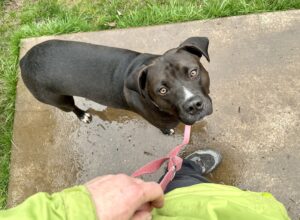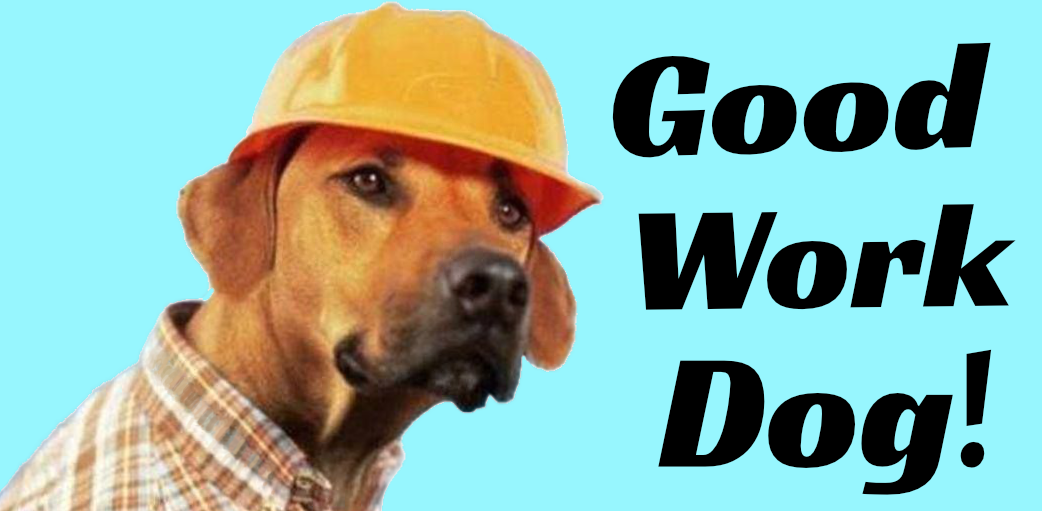Does your dog pull too hard on the leash? Do they drag you this way and that, lunge toward other dogs, and choke themselves as they go? I’m guessing yes, because almost everyone struggles with this problem, and here you are on a dog training website. I can help.
We have all tried different kinds of collars and equipment, hoping one of them will stop the pulling, and of course the makers of the equipment advertise that theirs is the real solution. But the reality is that for a dog to walk nicely on leash, they have to WANT to do that. People who use prong collars think that pinching the dog’s neck will make the dog change its behavior, but hurting the dog only builds resentment, and the dog doesn’t learn what you think it should. See my article about collars for citations. Slip leads and martingale collars obviously don’t help, because a dog will choke itself blue regardless of the collar, if it wants to pull. Harnesses are the best solution to prevent injury to your dog’s neck and throat from pulling, but they do not stop the pulling. No equipment, no matter how well advertised, can make a dog actually want to walk nicely by your side.
So what works?
There are two keys to building the nice leash walking behavior we want. One, we make it valuable to the dog to stay close to you. Two, we make it valuable to the dog to turn and orient toward you when you call them. If you got paid cash every time you did a certain activity, and that activity was easy and painless, you would probably be inclined to do it, right? The more reliable the cash payout, the more you wouldn’t even have to think about the choice. If you consistently give your dog its favorite reward every time it does a behavior you want, doing that behavior becomes valuable to the dog.
A note about treats: Most dogs love food, so we give them food treats. But the point isn’t to feed them “whatever”, the point is to find something they like so much that they will eagerly come back to you for more of it. If they get excited about their regular kibble, use that! If they aren’t enthusiastic for anything but string cheese, use that. If they don’t care so much about food, try a tug toy, a squeaky toy, or whatever your dog really wants more of. Ask your trainer about non-food reward strategies.
Walkies time!
Start by just walking around your home, with no leash. Any time the dog comes up to you, say ‘YES!’ and give them a treat. You don’t need to tell them to come, the treat is the communication for now. If the dog is not interested in coming to you, try shaking a bag of treats, squeaking a toy, or running around in a silly way. You CAN talk to them but avoid things like “Here! To me! Heel! Puppy puppy!” because we want the dog to solve this puzzle on their own, for more effective learning. Just walk aimlessly around and reward the dog each time it comes close. You can also do this in any safe fenced outdoor area. If you don’t have enough space either indoors or fenced, use a “long line”, basically an extra long (around 30 feet) leash or rope. Tie one end to their harness and the other end to your waist, and walk around any park or empty parking lot.
Once the dog starts following you around for more treats, the next step is to pay them only when they are by your side. Pick what side you want your dog to walk on, and when they go there, hold the treat down by the seam of your trousers on that side. Again you don’t need to tell them what to do, just wait for the moment when they are by the side you want, say YES and treat them close to your leg. It’s okay to pivot your own body relative to the dog, to help them be in the right spot. As you practice this over time, you will see the dog start increasingly moving to that side on their own. We create this “magic treat zone” by our side because a dog can’t pull ahead on leash at the same time as they are walking next to you. For the same reason, it makes them less likely to jump up on your front.
Elastic rebound
Time to change it up and help your dog return to your side after leaving. We want the dog to act like there is an elastic band connecting the two of you, so after “stretching out” by going to sniff at a tree or whatever, the dog will automatically “snap back” into position next to you. When the dog walks into the magic zone, say YES and toss a treat ahead of you on the ground, several steps away but making sure the dog can see it. When the dog runs to get the treat, it will then have a decision to make: wander around, look at you for instructions, or try doing something it knows has paid off previously–like returning to your side. It may stare, whine, pace, or do all sorts of other behaviors; you just wait patiently and quietly. Eventually the dog should try going to your side, and in that moment you say YES and throw another treat ahead, and repeat.
Once that is going well, it’s time to raise the difficulty again. Gradually increase the distance you walk before saying YES and treating. Treat at random intervals to keep your dog in a state of hopeful anticipation. Add distractions like talking to another person. And let’s finally take this practice out on the town!

Adding the leash
We want the leash to be like a car seat belt, not really doing anything until it is needed in an emergency. We did all the previous practices without a leash so your dog will walk nicely with you in general, so it should still walk nicely after you hook up the leash, which will hang loosely between you. That’s the goal! Going out to the street or park will bring new and powerful challenges, sights and smells that your dog will want to pull towards. That’s normal, and we can overcome it with practice.
When the dog pulls, just stop still and wait. If they don’t turn back to you, call their name, say ‘come’ or whatever recall cue you use, and when they come back to position then you can resume walking forward. Be sure to reward them for making the right choice! The more you do this, the more the dog will automatically understand what to do, without you having to constantly call them.
Sniffing at smells is important to your dog, and honestly for them that’s the main point of the walk, apart from going potty. So try to adjust your own walking so that you will stop at all the spots where your dog wants to sniff. When the dog learns that it will get the sniffing time it wants, it will be more willing to move there on your terms, instead of dragging you. Think of the sniffing as another kind of treat: if the dog walks by your side, it gets the reward of nice smells. Same with greeting other people and dogs, you only move toward them when your dog is walking nicely.
The big picture on leash
Some dogs will settle in to mostly nice walking, while others will continue to get over-excited by all the stimulating things out there. Instead of getting mad about it, we need to re-frame every walk as a training opportunity. Carry a bag of treats and reward every time your dog makes a good choice. The more you do, the less drama and difficulty it will involve. Your dog will pull less often, and it will come back into the magic zone with more ease and confidence.
The most important part is that walking will become a conversation between both of you, instead of you feeling like an ignored anchor on the leash. For best results you will need to be clear and precise in your timing and body language. These subtleties cannot be learned by reading an article. Instead, hire a private trainer! Look for one who uses “fear free” or “positive reinforcement” methods. They can help you notice and correct little errors that you may not see on your own. They can also help you find solutions for anything that frustrates you. Contact me, I am happy to help!
